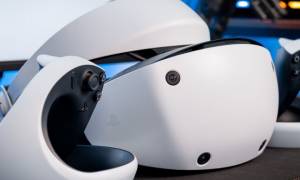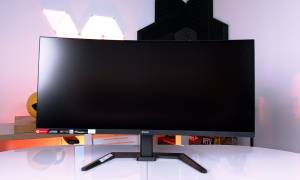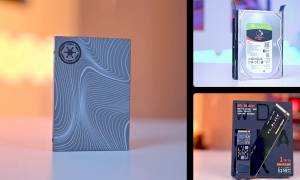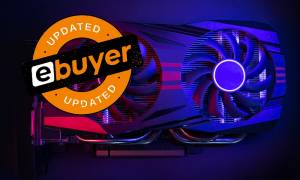Razer have updated their line-up of Blade gaming laptops for 2023, including a new Razer Blade 15, 16, and – for the first time ever – an enormous Razer Blade 18. Is this really the “desktop replacement” Razer’s touting it as? Let’s find out.
Build Quality and Portability

Like the rest of the line-up, the Razer Blade 18 features a CNC-milled aluminium unibody, anodised with a matte-black finish. Despite its size, the chassis is sturdy throughout. There’s hardly any deck flex, and while the finish isn’t immune to smudges they buff-out with a micro-fibre cloth easily enough to keep your Blade looking brand-new. Impressively, the hinge of the huge 18-inch display doesn’t wobble, even when thrashing away at the keys. And, of course, the Razer logo is backlit. Through software this can be set to static, breathing, or disabled outright.
Coming in at 3.1KG and 22mm-thick, the Razer Blade 18 isn’t exactly the most portable gaming laptop. By itself, it might not look all that big. Put it alongside a more average 15-inch laptop, however, and the sheer scale of the Razer Blade 18 becomes apparent. It’s likely you’ll have trouble finding laptop sleeves and bags big enough for it.
A decent portion of this weight no doubt comes from the hefty aluminium unibody plus the laptop’s 91.7WHr battery, which Razer says lasts for over 5 hours. That’s pretty impressive as far as a “desktop replacement” goes, and with USB Type-C charging you should be able to keep it topped-up throughout the day. Though given the Blade 18’s size, we’re surprised Razer didn’t opt for a 99.9WHr battery – the maximum capacity allowed by airlines.
They’ve put the extra chassis space to good use elsewhere, however. To keep frames high and temperatures low, the Razer Blade 18 is equipped with Razer’s largest ever vapour chamber cooler, as well as a third additional fan. And unlike most other gaming laptops on the market, the main power adapter of the Razer Blade 18 isn’t all that bulky. Razer’s bundled in a gallium nitride, or GaN, charger. It’s shockingly compact for a 280W brick, so it should be too much of a burden.
Connectivity and Features
Seeing as it’s the biggest Blade yet, the Razer Blade 18 has plenty of room for inputs and outputs. You’ll find 3x USB Type-As, 2x USB Type-Cs, a 2.5-gig ethernet jack, a full-sized SD card reader, and a HDMI 2.1 port – ready to drive the latest monitors and TVs at up to 4K 120Hz. One of these Type-Cs is Thunderbolt 4 and is connected directly to the discrete graphics, so it can be used as a DisplayPort 1.4 video output. What’s more, both of these Type-Cs can receive up to 100W of charging.
Opening up the Razer Blade 18, you’re greeted by two large front-firing speakers flaking the keyboard. In total, the 18’s got two tweeters and four subs all driven by THX Spatial Audio technology, lending them a wider perceived sound stage. Say you’re playing a first-person shooter, like Counter Strike. With THX Spatial Audio, it’ll be easier to pick out the sound of an enemy’s footsteps from the sound mix, so you can get the drop on them. They get quite loud too, but distortion settles in at max volume.
However, the real star of the show here is that massive glass touchpad, which is 50% larger than last year’s Razer Blade 17. This gives you smooth, precise navigation and gesture control when you’re without a mouse. In fact, it’s so large that you’re always touching it while typing, but strong palm rejection never made this a problem. The customisable, RGB-backlit keyboard has some snappiness to it, but there’s a fair bit of pre-travel which can leaving typing feeling a bit mushy.
Also, the keyboard’s got some quirks, like the power button. Unlike most other laptops, it’s integrated right into the keyboard, taking the Delete key’s usual spot. So, when you instinctively reach for Delete, you’ll hit the power button instead. Luckily, a slight tap doesn’t power off the laptop, but anything longer will put it to sleep. And despite this being an 18-inch form-factor laptop, the up-and-down arrow keys are squished together. You’d think they’d be full-sized given how roomy the keyboard’s deck is, but the keyboard on the Blade 18 and the smaller Blade 15 look to be identical. There’s no dedicated function row or number pad either. Not a deal-breaker to us, but a weird omission when even some budget 15-inch gaming laptops include these.
You’ll find a 5MP webcam at the top of the display, which… looks and sounds as you’d expect from a laptop webcam. But it does support 1440p video recording and Windows Hello facial recognition for fast, seamless unlocking.
High-Resolution, High-Refresh Rate Display

For those looking to create content on-the-go, the Razer Blade 18’s display is fantastic. It’s 2,560 by 1,600 pixels, which we’d say is the ideal resolution for a display of this size. 1,600p at 18-inches is pin-sharp and makes multi-tasking a breeze. Although it’s only a bit taller than 1440p on paper, in practice the extra vertical screen real estate of its 16:10 aspect ratio makes a big difference. It gives you that bit more room for lengthy text documents and video editing timelines, making the Razer Blade 18 a portable productivity workhorse. Plus, it uses a bright, punchy IPS panel with 100% coverage of the DCI-P3 colour gamut, so it’s suitable for colour-critical work. Clocked at a 240Hz refresh rate with a 3ms response time to boot, this NVIDIA G-SYNC compatible display is no slouch for gaming either.
Latest 13th-Gen Intel Core CPUs & NVIDIA RTX 40 Series GPUs
To drive this display, our machine features a NVIDIA GeForce RTX 4080 graphics card, but the Razer Blade 18 can also be configured with an RTX 4060, 4070, or 4090. Do note, however, that these are mobile chips, so they’re not like-for-like with the desktop counterparts. The RTX 4090 in a laptop, for instance, is very different to the RTX 4090 you’ll find in a desktop.
That being said, every Razer Blade 18 at least uses a max-wattage GPU, ensuring the best performance possible. Check out our What to look for in a high-end gaming laptop blog to learn about the ‘thermal design power’ or ‘total graphics power’ of a laptop GPU and why it’s important for performance. There’s also support for Advanced Optimus on the Razer Blade 18, letting its display automatically switch between the integrated graphics for better battery and the discrete graphics for better performance. And as it’s an RTX 40 Series GPU, you can enable DLSS 3 in select titles to push frame rates even higher with AI-powered image reconstruction and frame generation.
We’ve also got a 24-core, 32-thread 13th-Gen Intel Core i9 13950HX processor boosting up to 5.5GHz, as well as a 32GB of DDR5 RAM clocked at 5,600MHz and a 1TB PCIe Gen4 NVMe SSD. Razer doesn’t list the drive’s speed but from out testing it’s blisteringly-fast model, reaching a 6,704MB/s read and a 4,989MB/s write. The maxed-out configuration of the Razer Blade 18 is instead armed with a 2TB SSD, 64GB of RAM, and a 13980HX processor. Both the memory and storage are upgradable on the Razer Blade 18, with 2x DIMM slots, 2x M.2 slots, and support for dual-sided drives. To remove the Blade 18’s bottom panel and access these slots, however, you will need a less-common T5 Torx screwdriver.
Razer Synapse Software

In the Razer Synapse software that comes pre-installed on the Blade 18, you’ve got three performance profiles to choose from: Silent, Balanced, and Custom. These Balanced and Custom profiles don’t just ramp up the fan speed. Importantly, they also increase the power of the GPU and in turn its performance. With a maxed-out Custom profile, we saw a noticeable jump in frames-per-second over the Quiet profile, so you definitely want to enable at least the Default profile when gaming.
While running games in the Custom profile, CPU Package temperatures never went above 85-degrees. We could trigger thermal throttling by hammering the CPU with CineBench R23, but in a more real-world gaming scenario it’s clear that Razer’s cooling solution puts the work in. Razer must’ve been so confident in their cooling solution that they even updated Razer Synapse with a new “Overclock Mode.” It’s much like Intel’s Extreme Tuning Utility, letting you push the performance of the CPU even further than stock.
Make sure you check out our benchmarking video to hear how load the Blade 18 is under a heavy gaming load. As you’d expect from a gaming laptop with a Core i9 and an RTX 4080 crammed inside it, the Blade 18 can get pretty noisy. However, there’s no grating high-pitched whine, just more of a ‘whooshing’ sound that’s drowned out by headphones for the most part.
Another neat feature added to Razer Synapse is the ability to lock the display to 1080p 60Hz when unplugged as well as set the battery’s maximum charge level, both of which help preserve battery life and health.
Gaming Performance in Warzone, CS:GO, & Fortnite
While these tech-specs might look impressive on paper, let’s see how they translate to real-world gaming performance. To put the Razer Blade 18 through its paces, we’ve tested a variety of games at the display’s native 1600p resolution with high quality settings.
First up’s Call of Duty: Warzone 2.0. Featuring AAA-quality graphics and visuals, it’s a technical showcase of the latest iteration of Infinity Ward’s custom engine. Traversing the game’s large map, frame rates averaged out at around 100 frames-per-second, but we saw it peak as high as 150 frames-per-second while scavenging interiors for weapons.
Switching over to Counter Strike: Global Offensive, a more CPU-bound title, the Razer Blade 18 hit 190 frames-per-second pretty consistently. And with a high of 250 frames-per-second, there’s enough performance to saturate the Blade 18’s 240Hz display.
Rounding out our testing is Fortnite, which is an incredibly scalable title that’s available on hardware as weak as the Nintendo Switch. With its recent update to Unreal Engine 5, however, Fortnite can become quite intensive at high settings. Once we were on the ground, frame rates hovered about 90-110 frames-per-second.
How much does the Razer Blade 18 cost?
Now, the price. At launch, this Razer Blade 18 will set you back £3,799. For the top-spec RTX 4090 configuration, you’re looking at a cool £4,499. So, undoubtedly, these are some ultra, ultra-premium gaming laptops.
But with a seriously impressive 18-inch display, 13th-Gen Intel Core i9 processor, and NVIDIA RTX 40 Series discrete graphics, we could absolutely see ourselves daily driving the Razer Blade in place of a desktop.
We could imagine on-the-road influencer types, or those who travel for work frequently, getting a lot of mileage out of the Razer Blade 18. Everything’s here for a fantastic gaming experience and content-creation experience, wherever you’re posted up – no need for an external monitor or a dedicated tower.
Razer Blade 18 at Ebuyer
So, are you thinking about picking up a Razer Blade 18? Head on over to Ebuyer to see the full line-up of Razer Blade 18 gaming laptops for yourself, and check out Ebuyer’s YouTube channel for Razer Blade 18 unboxings and benchmarks.



























